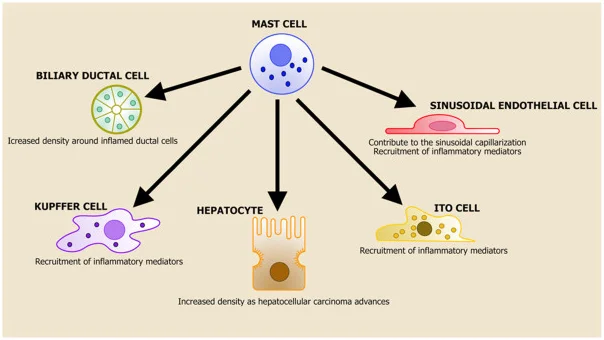The major cell of the liver is the hepatocyte makes up 70–85% of the cytoplasm of the liver cells. These cells produce bile which in turn is modified by other cells called cholangiocytes. According to researchers Hargrove and team in Laboratory investigation; a journal of technical methods and pathology, these, mast cell contribute 3–5% of the liver’s mass in terms of the cytoplasm. The other cells are vascular endothelial cells, Kupffer cells and hepatic stellate cells. Each cell can be a target of diseases- hepatocellular carcinoma, hepatitis and non-alcoholic fatty liver disease target the hepatocytes while a group of conditions known as cholangiopathies affects the cholangiocytes.
Dr. Paul Ehrlich had mentioned the word “mast cells” in 1878. Mast cells are inflammatory cells that are not only present as residents of tissues but can also be recruited due to signals or injuries. These cells were considered to be responsible for mediating allergies using histamine molecules but ongoing research has identified the role of these cells in many liver diseases. According to scientists Jarido and team who reviewed the role of these cells in diseases in the American Journal of physiology, mast cells are involved in infectious, inflammatory as well as autoimmune disorders.
Hematopoietic stem cells are the source of mast cells with the cells circulating as immature progenitors in the blood and lymph. Mast cells are found near blood vessels, lymph vessels and nerves. The liver tissue near the liver blood vessels and bile ducts in both mice and humans contain mast cells in small numbers in healthy conditions.
The number of mast cells has found to increase during liver diseases. For example, depending on their origin mast cells show the expression of enzymes such as chymase, protease and tryptase. Mast cells of the connective tissue express chymase while mucosal mast cells express protease and tryptase. 2016-published research in The American Journal of Pathology by Johnson and team reported that the numbers of mast cells (chymase-positive and tryptase-positive) increased in the disease cholangiocarcinoma. The study also reported the potential use of mast cell markers such as chymase and tryptase to serve as biomarkers of human cholangiocarcinoma given that the disease yet lacks suitable markers for diagnosis.
Scientists Ann Tolefree and team reported in Liver Research in 2019 that the factors secreted by mast cells can increase the inflammation seen in Alcoholic liver disease (ALD). This disease is yet to see any FDA-approved or true treatment. The progression of the disease shows that mast cells influence the bacteria of the gut (known as the microbiota) to influence the development of ALD. This opens up an avenue of treating ALD by controlling mast cell activation.
Given these interesting aspects of mast cell, isolating these cells becomes important to study them further in detail. According to 2019-published data in The Journal of Hepatology, 2 million people die every year due to liver disease! As mast cells are involved in several liver diseases such as primary sclerosing cholangitis (PSC), primary biliary cholangitis (PBC), bile duct obstruction, steatosis and fibrosis, studying these cells in vitro allows for not only understanding such diseases in detail but also look at developing treatments that target these mast cells and lower the burden of liver diseases on the world.
If you are passionate about liver research and are looking at studying mast cells of the liver, Kosheeka supplies these cells at high quality to contribute to research.
References:
Hargrove L, Graf-Eaton A, Kennedy L et al. Isolation and characterization of hepatic mast cells from cholestatic rats. Laboratory investigation; a journal of technical methods and pathology 2016; 96(11), 1198–1210.
Jarido V, Kennedy L, Hargrove L et al. The emerging role of mast cells in liver disease. American journal of physiology. Gastrointestinal and liver physiology 2017; 313(2): G89–G101.
Johnson C, Huynh V, Hargrove L, Kennedy L et al. Inhibition of Mast Cell-Derived Histamine Decreases Human Cholangiocarcinoma Growth and Differentiation via c-Kit/Stem Cell Factor-Dependent Signaling. The American Journal of Pathology 2016 Jan; 186(1):123-33.
Julie Ann Tolefree, Abigail Joy Garcia, Jenee Farrell et al. Alcoholic liver disease and mast cells: What’s your gut got to do with it? Liver Research 2019 3(1): 46-54.
Asrani SK, Devarbhavi H, Eaton J, Kamath PS. Burden of liver diseases in the world. The Journal of Hepatology 2019 Jan;70(1):151-171.



